Radio engineering training courses offered by Wray Castle Ltd are designed to equip individuals with the knowledge and skills needed to excel in the ever-evolving field of radio engineering. Whether you are a beginner looking to kickstart your career or a seasoned professional seeking to enhance your expertise, our comprehensive courses cater to learners at all levels.
Our radio engineering training courses cover a wide range of topics, including radio frequency (RF) theory, antenna design, propagation models, modulation techniques, signal processing, and more. Through a combination of theoretical lectures, hands-on practical exercises, and real-world case studies, participants will gain a deep understanding of the principles and practices that underpin modern radio systems.
At Wray Castle, we understand the importance of staying up-to-date with the latest advancements in radio technology. That's why our courses are regularly updated to reflect the most current industry trends and standards. Whether you are interested in traditional analog radio systems or cutting-edge digital technologies like 5G and LTE, our training programs will provide you with the knowledge and skills needed to succeed in today's fast-paced telecommunications landscape.
In addition to our comprehensive course content, participants will also have access to a range of learning resources and support tools through the Wray Castle Hub. From interactive webinars and digital badges to expert tutor guidance and industry glossaries, our platform is designed to enhance the learning experience and help you achieve your professional goals.
By enrolling in our radio engineering training courses, you will not only enhance your technical skills but also boost your career prospects in the telecommunications industry. Join the thousands of learners who have trusted Wray Castle Ltd for their training needs and take the next step towards a successful career in radio engineering.
Radio Engineering Training Courses
-
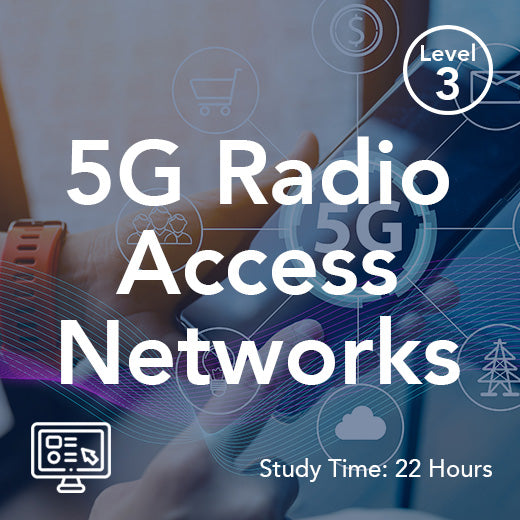
5G Radio Access Network (On-Demand)
The 5G Radio Access Network on-demand course begins by discussing the key features of a 5G network before delving into the finer detail of the 5G New Radio. The 5G RAN is described in terms of network architecture, base station characteristics, spectrum usage and multiple antenna configurations. The transport of signalling and traffic over the 5G RAN interfaces, fronthaul and backhaul are analysed followed by an in depth study of the signalling protocols used over those interfaces. This self-paced on-demand distance learning course features illustrated course books, videos, tests and full tutor support. Who Would Benefit Engineers that need to know about the 5G Radio Access Network in terms of its characteristics, architecture, interfaces and operation Prerequisites Ideally students will have a mobile telecommunications or radio background gained from the study of or working with GSM, UMTS or LTE networks. Topic Areas Include Introduction to 5G 5G RAN NG Interface Messages and Procedures Xn Interface Messages and Procedures E1 Interface Messages and Procedures F1 Interface Messages and Procedures Multi-RAT Dual Cennectivity
£750.00
-
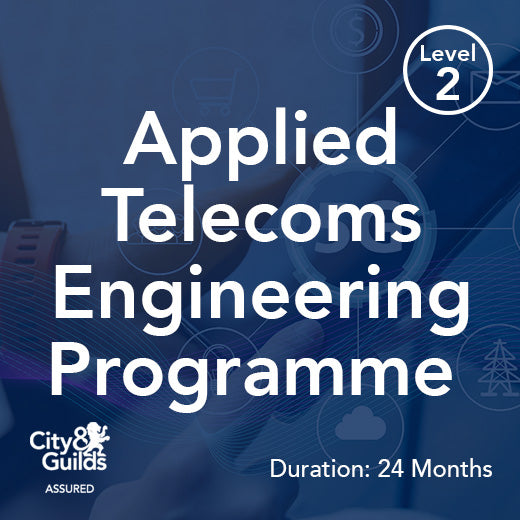
Applied Telecoms Engineering Programme (Cellular Radio Engineer)
The Applied Telecoms Engineering Programme (Cellular Radio Engineer Track) distance learning programme provides learners with a qualification that demonstrates their knowledge of the technologies underpinning the telecoms industry with a focus on cellular radio engineering. Students will gain a through foundation in the telecoms industry and the technologies on which it’s based as well as a comprehensive understanding of the technologies underpinning radio access networks and techniques needed to design, plan, build, monitor and optimise modern cellular radio networks. This programme has been assured by City & Guilds. Assured status provides validation and recognition for the learner. It is a symbol of learning excellence and quality and is a reassurance that the training undertaken meets best practice standards. Applied Telecoms Engineering Programme (Cellular Radio Engineer Track) Syllabus Foundation Courses Technology Fundamentals Course Modules: Defining Telecoms Background to the Telecom Network Digital Fixed Telecom Networks Data Networks Mobile Networks and Wi-Fi Broadband and Emerging Networks 2G to 5G Mobile Technologies Course Modules: Principles of Mobile Cellular Networks 2nd Generation Mobile Networks 3rd Generation Mobile Networks 4th Generation Mobile Networks 5th Generation Mobile Networks Telecoms – as an Industry and Business Course Modules: Telecoms Industry & Business Dynamics The Technology Explained & Evaluated Telecoms Industry & Market Update Specialist Courses LTE Air Interface Course Modules: LTE Overview OFDM Principles Physical Layer Structure Layer 2 Protocols Radio Resource Control LTE-Advanced Lower Layer Procedures 5G Air Interface Course Modules: Principles of the 5G New Radio Introduction to the Physical Layer Physical Layer Implementation and Procedures Higher Layer Protocols Signalling Procedures What you will learn: At the end of the programme successful students will be able to: Develop a fundamental understanding of the technologies underpinning modern telecoms networks, the industry structure and its key stakeholders . Gain a detailed understanding of the air interface for LTE radio access (incl. OFDMA principles, channel structures, connectivity and mobility management and radio link control functions.) Have a detailed technical understanding of the air interface for the 5G New Radio, the principles of mm wave and multiple antenna communications, the architecture of the AI’s physical layer, the higher layer air interface protocols, and the signalling procedures. Expand their learning further by studying two elective modules to qualify for the Diploma in Telecoms. What sets the programme apart? Focused Learning Pathways – guide you through the material and enable you to become an expert in your chosen field. Flexible Learning – study at a time, location and pace of your choice. Full Tutor support – from industry experts with decades of experience throughout your studies. Extended Learning – Diploma students have the opportunity to study 3 additional courses. 24 months access – allowing you to refer back to the material after your studies. Digital Badges and Course Certificate – demonstrate the depth of your knowledge. About City & Guilds City & Guilds is a household brand and a global leader in skills development. Over one million people earn a City & Guilds qualification every year, providing them with the skills they need to thrive in the workplace.In the global economy, the ability to compete depends on building a skilled, competent and confident workforce. City & Guilds understands the value of portable skills and globally recognised standards that enable people and organisations to succeed. It partners with Governments, employers and educators in over 50 countries, across five continents, to advise them on developing high-quality skills training that meets the needs of the global workforce, without compromising on local demands. Enrolment Fees: £2,995 (+VAT) Programme Duration: 24 months (Programme is On-Demand, learners can start at any time) Bespoke In-Company Schemes The Applied Telecoms Engineering Programme provide the ideal structure for formalising training programmes for teams across your business. Contact us on info@wraycastle.com for more information.
£2,995.00
-

Approaches to Satellite Compatibility (LS telcom)
The increase in new Low Earth Orbit satellite constellations has resulted in a surge of compatibility studies being carried out to understand how Non-Geosynchronous Orbit (NGSO) and Geosynchronous Orbit satellites (GSO) can coexist. The issue has arisen from the demand in new high speed broadband services but also the cost of producing and launching satellites into orbit reducing greatly in recent years. There are many complexities in solving the compatibility between NGSO and GSO systems due to the muti-dimensional and highly dynamic nature of both systems. We will focus on the main technical parameters and calculations that are used to determine the unacceptable levels of interference. The course will look across the different services including MSS, FSS (BSS) but also protection of EESS in a range of frequency bands. This course will also touch upon the two approaches to Direct to Device services. This is the use of Mobile Satellite Service spectrum but also Mobile Service spectrum bands. We will cover the implications and challenges of adopting each approach and how regulations will need to evolve to support these approaches. Course Objectives After completing the course, participants will be aware of the technical complexities of conducting compatibility studies that take place within the ITU. It will provide participants with the knowledge of the main technical parameters and calculations needed to determine interference levels. Participants will have an understanding how NGSO and GSO will be able to coexist. Intended for people working at regulators, satellite operators and vendors with some technical knowledge of satellite technologies and radio regulations and some knowledge of the ITU-R processes. The course is also suitable for non-technical people within government departments and ministries who wish to understand all the relevant complexities of compatibility studies and processes for updating the regulations. Contents Introduction to satellite technologies and deployments including definition of GSO and NGSO satellites Technical parameters used for compatibility studies Analysis of interference calculations for compatibility Overview of ITU working party study practices and example compatibility exercise Basic interference and compatibility calculations Overview of D2D spectrum approaches About LS telcom: LS telcom is a global leader in technologies and consulting services for efficient radio spectrum use, optimizing spectrum management to ensure reliable, interference-free, and secure radio services. Our portfolio includes consulting, measurement services, and integrated solutions for planning, analysis, monitoring, and managing radio infrastructure. Serving customers in over 100 countries, including regulatory authorities, network operators, and industries such as transport, utilities, and security, LS telcom operates globally with subsidiaries and offices in locations like Germany, the UK, Canada, India, and the UAE. Headquartered in Lichtenau, Germany, LS telcom AG has been listed on the German Stock Exchange since 2001 (ISIN DE 0005754402).
£1,300.00
-
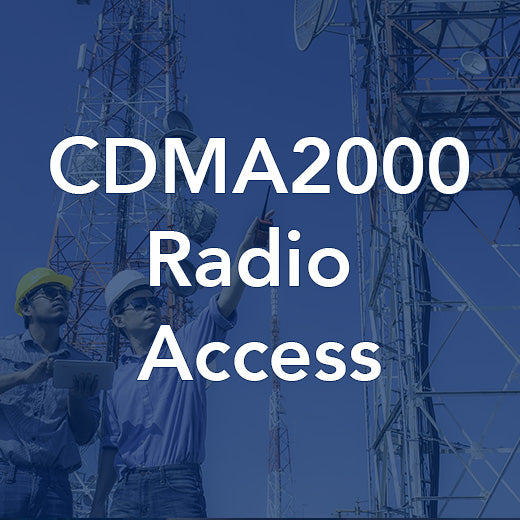
CDMA2000 Radio Access
Course Code: MB2103 Course Summary This course begins with an overview of CDMA2000™ origins, the key standardization work as well as general network architecture. The course continues with an engineering overview of CDMA operation in a 3G context; one of the underpinning technologies and is followed by a brief review of cdmaOne™. Who would benefit Engineering staff working on CDMA access networks requiring an understanding of the operation and capabilities of the CDMA2000™ 1x and 1xEV-DO systems. Prerequisites A good understanding of modern digital cellular communication techniques and, ideally, some experience of cdmaOne/IS-95 operation. Topic Areas Include Evolution of 3G network architecture cdmaOne overview CDMA principles in 3G systems Access and core network elements and interfaces 1x and 1xEV options available for CDMA2000™ Radio link higher-layer protocols Link Access Control (LAC) protocol Medium Access Control (MAC) protocol 1xEV-DO protocol stack 1x and 1xEV-DO channels 1x and 1xEV-DO physical layer structure System access, call processing and handover
POA: Private Course
-
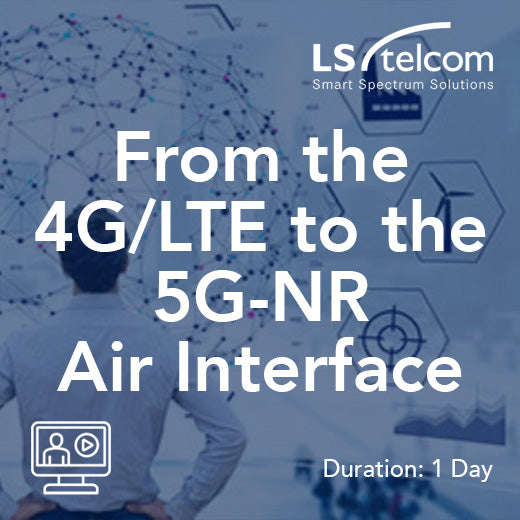
From the 4G/LTE to the 5G-NR Air Interface (LS telcom)
This training course is aimed at those people working within the wireless communication business or broadcast business. Participants will get an overview on the 4G/LTE and 5G-NR physical layer. First of all wireless communication basics like OFDMA, DFTs-OFDMA, Forward Error Correction and MIMO will be discussed followed by an in-depth overview of 4G and 5G technology and standards. The training is presented in cooperation with Rohde & Schwarz. Course Objectives After completing this course, delegates will understand the technology behind 4G and 5G. Focus is on the physical layer not on the protocol level. Several practical demonstrations will solidify the theoretical knowledge. Intended for This course is intended for those who have a basic knowledge in information technology, who may be employed in network operators or regulators. Contents Wireless Communication Basics 4G/LTE Standard 5G Standard About LS telcom: LS telcom is a global leader in technologies and consulting services for efficient radio spectrum use, optimizing spectrum management to ensure reliable, interference-free, and secure radio services. Our portfolio includes consulting, measurement services, and integrated solutions for planning, analysis, monitoring, and managing radio infrastructure. Serving customers in over 100 countries, including regulatory authorities, network operators, and industries such as transport, utilities, and security, LS telcom operates globally with subsidiaries and offices in locations like Germany, the UK, Canada, India, and the UAE. Headquartered in Lichtenau, Germany, LS telcom AG has been listed on the German Stock Exchange since 2001 (ISIN DE 0005754402).
£2,240.00
-

IP Microwave and E Band Planning
Course Code: RP1306 Course Summary This course introduces some of the key techniques used in the latest products related to microwave radio. Topics covered include adaptive modulation; radio link protection and bonding; fixed link MIMO; Internet Protocol (IP) radio; Ethernet QoS management; header compression and split mount; and full outdoor configuration. The course looks at how vendors and network planners are addressing the issues associated with upgrading from legacy microwave technologies (PDH/SDH) to full IP. The emerging E-band technology is discussed in detail, with a particular emphasis on planning E-band links and the technical specifications of a range of equipment from the main vendors. Who would benefit This course is intended for experienced transmission and backhaul engineers and system architects requiring an in-depth understanding of the evolution of fixed broadband radio. Prerequisites A good knowledge of radio principles would be desirable, as well as an appreciation of IP technologies. Topic Areas Include Ethernet Radio Spectrum and Regulation Technological Developments in Fixed Link radio Planning IP and E-Band Radio Links Timing and Synchronization
POA: Private Course
-
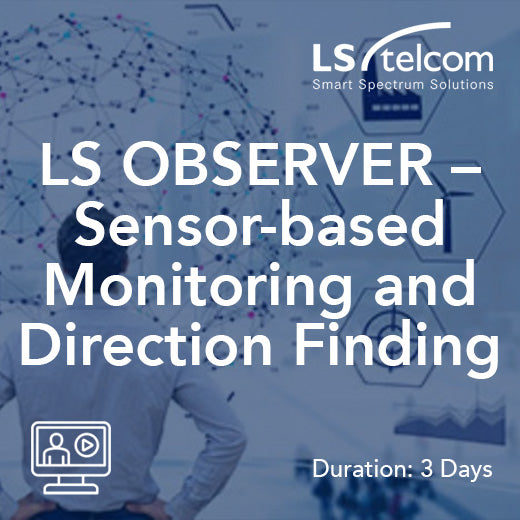
LS OBSERVER – Sensor-based Monitoring and Direction Finding (LS telcom)
The LS OBSERVER system training introduces the features of the LS OBSERVER based monitoring units and the principles of operation as sensor-based systems. The course contains the detailed description of the operation of all features and allows the participants to perform practical tasks with the LS OBSERVER system. The service-oriented system configuration and architecture, the remote control of measurement units, the measurement data download, multiple geolocation methods, the analysis of measurement results and direction finding techniques will be presented. The participants will have the possibility to use the equipment for practical tasks during the training. Information about maintenance requirements and configuration of the system are also covered by the training. Course Objectives The training enables the participants to become familiar with the LS OBSERVER monitoring units and the associated software module LS OBSERVER CMS. They will understand the functionalities, handling the GUI and learn how to perform measurements and analysis with the focus on remote controlled monitoring, geolocation and direction finding. Finally, they will see how a fully integrated spectrum management (e.g. SPECTRAplus) and monitoring system can be managed and be used for combined tasks (e.g. automatic violation detection). Intended for This course is intended for monitoring personal who have a basic knowledge of radio monitoring and geolocation methods and who need to operate LS OBSERVER units for measurement, direction finding and analysis tasks. Contents Global overview of the LS OBSERVER service-oriented architecture Typical system and network setup and configuration GUI concept and handling Wide-band measurements Fixed frequency measurements Recording of the measurement results Direction Finding AoA measurements Geolocation with TDoA and GROA+® DF Time Travel® AoA combination of TDoA, GROA+® and AoA results Data handling, download from remote monitoring units About LS telcom: LS telcom is a global leader in technologies and consulting services for efficient radio spectrum use, optimizing spectrum management to ensure reliable, interference-free, and secure radio services. Our portfolio includes consulting, measurement services, and integrated solutions for planning, analysis, monitoring, and managing radio infrastructure. Serving customers in over 100 countries, including regulatory authorities, network operators, and industries such as transport, utilities, and security, LS telcom operates globally with subsidiaries and offices in locations like Germany, the UK, Canada, India, and the UAE. Headquartered in Lichtenau, Germany, LS telcom AG has been listed on the German Stock Exchange since 2001 (ISIN DE 0005754402).
£2,600.00
-
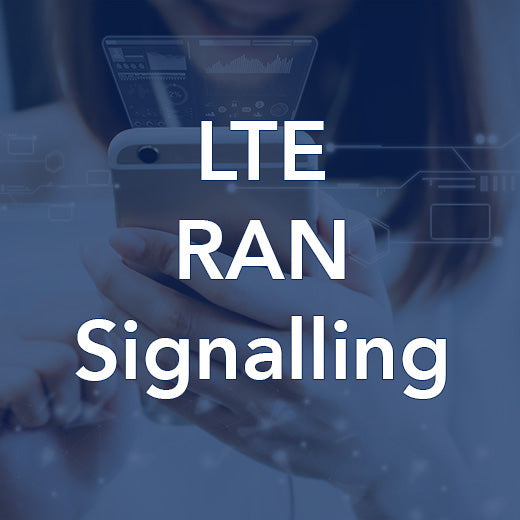
LTE RAN Signalling
Course Code: LT1606 Who Would Benefit Engineers involved with equipment design, operation, optimization or monitoring of the LTE Radio Access Network. Prerequisites Familiarity with LTE and the LTE RAN is assumed and can be gained from attending the LTE Engineering Overview (LT3600) course. Experience of 2G or 3G air interface signalling systems would be beneficial. This course is not suitable for those who have attended the LTE RAN course (LT3603) as it covers similar signalling topics. Contents LTE Signalling Protocols and Interfaces S1 Interface Messages and Procedures X2 Interface Messages and Procedures
POA: Private Course
-
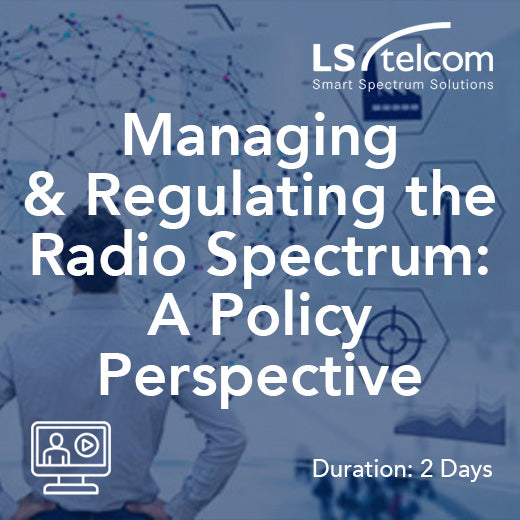
Managing and Regulating the Radio Spectrum: A Policy Perspective (LS telcom)
The radio spectrum is a limited resource that has to be shared between different services, technologies, users and countries. It is the task of regulatory authorities to manage the resource and to optimize its use. International frameworks provide the basis for spectrum management, however knowledge of the characteristics of the radio spectrum and technologies that use it are necessary for these frameworks to be translated into realizable policies and practices at a national and regional level. This course provides an overview of the goals of spectrum management as well as delivering an understanding of the specific characteristics of different parts of the radio spectrum and how this impacts its utility and value. The use of different spectrum bands is discussed, together with a consideration of the way in which historic and new radio technologies use spectrum and the techniques being considered to maximize efficiency and sharing. Different facets of spectrum management and regulation are explained. The course explores assignment and planning methods from the classical command and control techniques to developments in economic techniques such as pricing, trading and auctions. It takes a look at techniques such as spectrum sharing and dynamic access and licensed shared access to help understand what failings of existing techniques they are seeking to redress. Course Objectives After completion of the course, participants will understand how the radio spectrum is used, and approaches to its management and regulation with respect to setting certain policies. They will have extended their knowledge of spectrum management and will have been updated on the latest techniques and processes being employed. Intended for This course is ideal for those working in a policy development and technical/non-technical positions within a spectrum regulator or regulatory body. It is useful for those who wish to deepen their knowledge of the toolkit for spectrum regulation and management including consultants, investors, manufacturers, major spectrum users and those for whom managing the spectrum is a part of their daily job. Contents Characteristics of radio spectrum and radio technologies The international framework and processes for spectrum management Translating spectrum characteristics into policy levers Evolution of spectrum assignment approaches Spectrum sharing; a paradigm to innovative spectrum management About LS telcom: LS telcom is a global leader in technologies and consulting services for efficient radio spectrum use, optimizing spectrum management to ensure reliable, interference-free, and secure radio services. Our portfolio includes consulting, measurement services, and integrated solutions for planning, analysis, monitoring, and managing radio infrastructure. Serving customers in over 100 countries, including regulatory authorities, network operators, and industries such as transport, utilities, and security, LS telcom operates globally with subsidiaries and offices in locations like Germany, the UK, Canada, India, and the UAE. Headquartered in Lichtenau, Germany, LS telcom AG has been listed on the German Stock Exchange since 2001 (ISIN DE 0005754402).
£1,300.00
-

Microwave Link Planning
Course Code: RP1601 The course covers all of the essential aspects of planning point-to-point microwave link systems, from conception to commissioning. Who would benefit Those involved in the specification, planning and maintenance of fixed microwave radio transmission, backhaul and access links. Prerequisites A good knowledge of radio principles, or a background in telecommunications engineering, or attendance on the Radio Principles course (RP1301). Topic Areas Include ITU-R and CEPT recommendations ETSI standards Spectrum management and channel plans Frequency assignment Digital radio performance characteristics Noise and interference in radio systems Reliability, availability and performance objectives Microwave antennas and feeders Radiation Pattern Envelopes (RPEs) Refraction, k-factor, reflection and diffraction Path profiling and Fresnel zone clearance Power budgets Rain and Multipath/Dispersive fade margins Dimensioning space and frequency diversity Interference management Practical link planning exercises Practical exercises, including design of a fixed link transmission network. Trainer: Karl van Heeswijk Karl is an experienced training specialist in radio theory, point-to-point, point-to-multipoint and mobile systems.
POA: Private Course
-
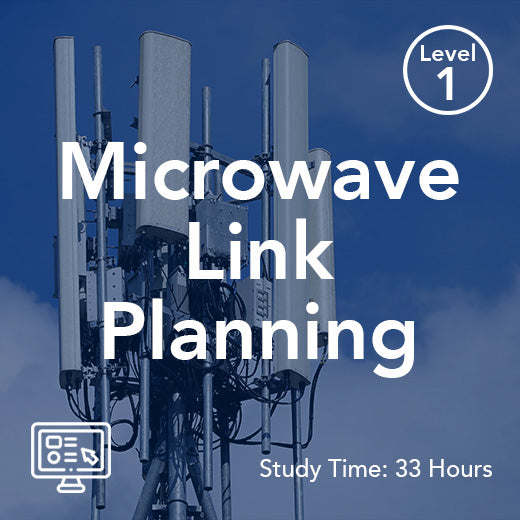
Microwave Link Planning (On-Demand)
The course covers all of the essential aspects of planning point-to-point microwave link systems, from conception to commissioning. Who would benefit Those involved in the specification, planning and maintenance of fixed microwave radio transmission, backhaul and access links. Prerequisites A good knowledge of radio principles, or a background in telecommunications engineering, or attendance on the Radio Principles course (RP1301). Topic Areas Include ITU-R and CEPT recommendations ETSI standards Spectrum management and channel plans Frequency assignment Digital radio performance characteristics Noise and interference in radio systems Reliability, availability and performance objectives Microwave antennas and feeders Radiation Pattern Envelopes (RPEs) Refraction, k-factor, reflection and diffraction Path profiling and Fresnel zone clearance Power budgets Rain and Multipath/Dispersive fade margins Dimensioning space and frequency diversity Interference management Practical link planning exercises Practical exercises, including design of a fixed link transmission network. On-Demand Online Training Our self-paced on-demand distance learning programmes are accessible on any computer, tablet or smartphone and allow you to study at a time and location that is convenient to you. Each course includes: Illustrated Course Books - featuring leading edge knowledge from subject matter experts. Videos - Detailed videos expand the points covered in the course books, discussing topics in greater depth. Tutor Support – Dedicated course tutors are available to answer any questions you might have throughout your studies. Formative Assessment - Modules include regular quizzes to support learning by testing your knowledge of the subject matter. Certification– Successfully complete the end of module tests to earn Digital Badges to demonstrate the depth of your knowledge of the topic. Also available as a Live Online Training, Learn more
£2,660.00
-
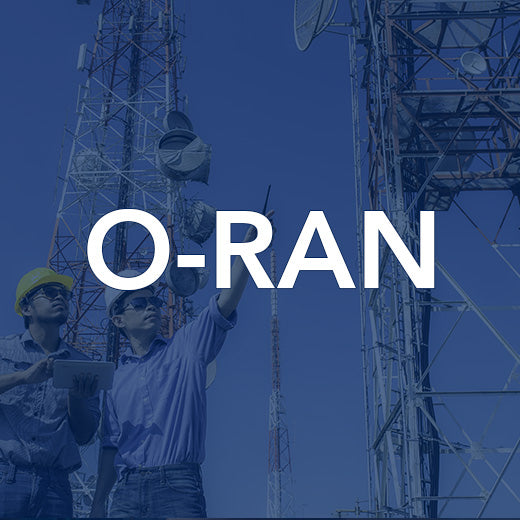
Open Radio Access Networks (Open RAN)
Course Code: RP2401 Open RAN set to transform the Radio Access Networks (RAN) and in turn the Industry that supports it. The ORAN Alliance is working towards an architecture which is open, intelligent, virtualized and fully interoperable with the intention of enabling a more competitive and innovative RAN supplier ecosystem. For the telecommunications operator, Open RAN-compliant mobile networks improve the efficiency and flexibility of RAN deployments and operations – both essential as networks are densified, and as they evolve through the deployment phases of 5G. This course provides a solid introduction to Open RAN, exploring the purpose, features, architecture, operation and deployment options. The way Open RAN principles, and its foundation in virtualisation, supports the evolution to 5G is also discussed, as well as the impact of using ORAN architecture on both the open and standardised interfaces. Who would benefit Those in or entering technical roles in a mobile network operators Radio Access Network (RAN) environment. Prerequisites A basic understanding of cellular radio networks from a radio network perspective as well as the ability to comprehend technical subjects, would be useful. Topic Areas Include Radio Access Networks ORAN Players 3GPP RAN Architecture for 5G Open RAN, O-RAN Operations and Maintenance Whitebox Basestations Trainer: Les Granfield Les is a technical trainer with 35 years of experience. His expertise extends across a wide range of telecommunications technologies. He specializes in GSM, GSM-R, ERTMS/ETCS, UMTS and LTE radio access networks, radio planning, radio access network optimization and Push to Talk over Cellular (PoC).
POA: Private Course
-
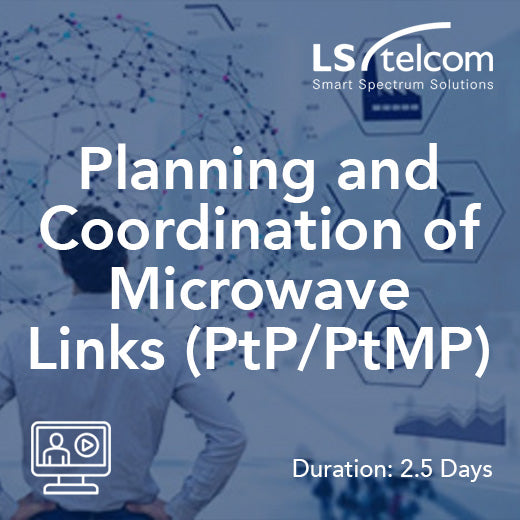
Planning and Coordination of Microwave Links (PtP/PtMP) (LS telcom)
Modern transmission networks require communication links with high link capacity and availability. Microwave Point-to-Point (PtP) and Point-to-Multipoint (PtMP) systems can provide the required performance if the links are designed appropriate. Theoretical know-how combined with best practice for link engineering and design ensures that the possibilities of modern link technology will be fully available after implementation. The course introduces both theoretical and practical knowledge in planning of microwave links. Topics touched cover wave propagation, link budget and availability calculations as well as technical parameters of antennas and microwave devices. Best practice for the analysis of path profiles including line of sight aspects, selection of antenna, modulations scheme and frequency band is provided. Availability engineering of links is discussed as well as frequency and capacity planning for complex transmission networks. This includes the effective use of frequency raster and the analysis of network interference to achieve low interference and high frequency reuse. Course Objectives After completing the course, delegates will be familiar with the principles of microwave radio link planning and will be in the position to design individual microwave links as well as complete PtP and PtMP networks. Intended for This course is intended for those who have basic knowledge in radio communications and microwave link technology, who are interested in microwave link planning and who may be employed in regulators, telecoms operators and utility or transportation companies. Contents Spectrum regulation and licensing aspects Relevant ITU recommendations Wave propagation and effects ITU propagation models Path profile analysis Microwave devices and antennas Availability and error performance Link budget calculation Frequency planning and channel assignment Interference analysis and network optimization About LS telcom: LS telcom is a global leader in technologies and consulting services for efficient radio spectrum use, optimizing spectrum management to ensure reliable, interference-free, and secure radio services. Our portfolio includes consulting, measurement services, and integrated solutions for planning, analysis, monitoring, and managing radio infrastructure. Serving customers in over 100 countries, including regulatory authorities, network operators, and industries such as transport, utilities, and security, LS telcom operates globally with subsidiaries and offices in locations like Germany, the UK, Canada, India, and the UAE. Headquartered in Lichtenau, Germany, LS telcom AG has been listed on the German Stock Exchange since 2001 (ISIN DE 0005754402).
£1,300.00
-
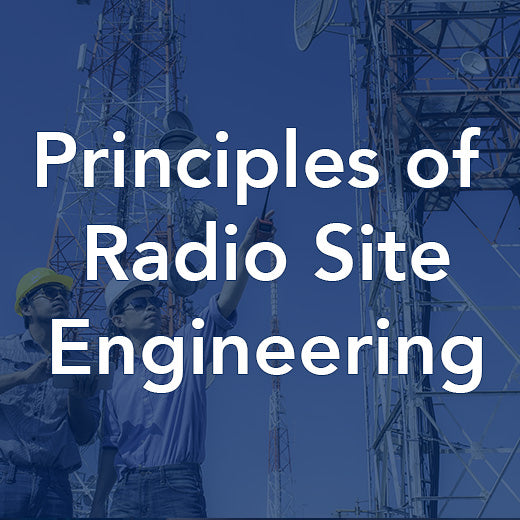
Principles of Radio Site Engineering
Course Code: RP2100 This course is intended for those involved in radio site acquisition, planning and build, who do not have a strong radio background. The training covers radio theory applicable to the cellular industry and focuses on the practical issues of site build. Who would benefit Those requiring an overview of what is involved in the siting of telecoms transceiver equipment in radio sites. Prerequisites No prior knowledge of radio principles is required. A technical background or the ability to comprehend technical information is advantageous. Topic Areas Include Radio theory Radio wave propagation Antenna theory Considerations for siting antennas Transmission lines Considerations for installing transmission lines Cell dimensioning Cell site selection and positioning Indoor coverage challenges Indoor coverage using repeaters Indoor coverage using base stations Antenna systems for indoor coverage Radio systems interference Multi-site configurationsEarthing UK planning issues Trainer: Les Granfield Les is a technical trainer with 35 years of experience. His expertise extends across a wide range of telecommunications technologies. He specializes in GSM, GSM-R, ERTMS/ETCS, UMTS, LTE and 5G radio access networks, radio planning, radio access network optimization and Push to Talk over Cellular (PoC).
POA: Private Course
-
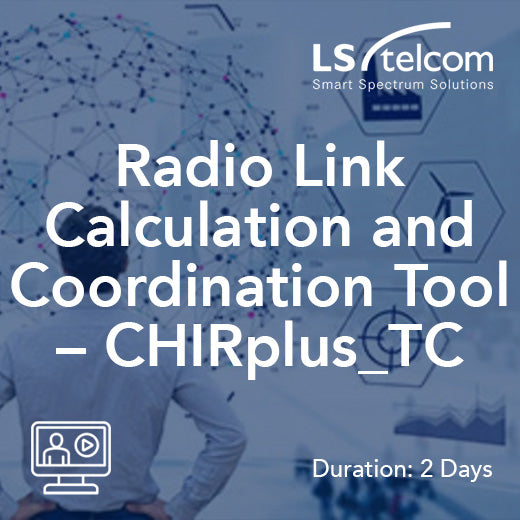
Radio Link Calculation and Coordination Tool – CHIRplus_TC (LS telcom)
The design of microwave links requires complex calculations to dimension link capacity and availability or to assign frequencies. The planning tool CHIRplus_TC provides the required functionality in a user-friendly way and is essential for proper link design. The seminar introduces essential features to perform link engineering and planning tasks for Point-to-Point and Point-to-Multipoint systems. The first day is dedicated to the general tool handling. The different database functions and configurations are presented and discussed with the delegates. The following days will cover the necessary steps to perform typical link calculations - from data input over the setting of required parameters to the calculations analyses. Finally, reports and data export options will be presented. The entire workflow that is required to execute microwave radio link planning tasks as well as the Point-to-Multipoint network planning process is covered. Additionally, an overview of further network technologies included in the Net Module will be introduced. Course Objectives After the training the delegates will be able to efficiently solve link planning and coordination tasks using CHIRplus_TC and to interpret the calculation results for microwave links and Point-to-Multipoint networks. Intended for This course is intended for those who have basic knowledge in radio communication and microwave link design and who are interested in the functionality provided by CHIRplus_TC. Contents Setup and configuration of CHIRplus_TC Interaction with the Graphical User Interface (GUI) Usage of databases and spreadsheets (especially filtering) Point-to-Point microwave link design Path profile and link budget Reliability/availability analyses Frequency planning and network optimization Interference calculation and complete network analyses Point-to-Multipoint network planning Net Module: Overview of network technologies Data import and export, reports and documentation About LS telcom: LS telcom is a global leader in technologies and consulting services for efficient radio spectrum use, optimizing spectrum management to ensure reliable, interference-free, and secure radio services. Our portfolio includes consulting, measurement services, and integrated solutions for planning, analysis, monitoring, and managing radio infrastructure. Serving customers in over 100 countries, including regulatory authorities, network operators, and industries such as transport, utilities, and security, LS telcom operates globally with subsidiaries and offices in locations like Germany, the UK, Canada, India, and the UAE. Headquartered in Lichtenau, Germany, LS telcom AG has been listed on the German Stock Exchange since 2001 (ISIN DE 0005754402).
£1,865.00
-
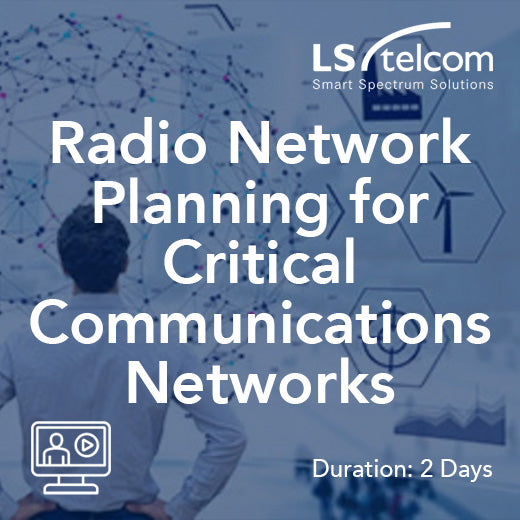
Radio Network Planning for Critical Communications Networks (LS telcom)
Radio networks for professional use in public safety, transportation, utilities, and industry must provide reliable communication for mission critical applications. The use of appropriate design parameter and planning procedures is crucial to achieve the required network performance. This course provides a solid understanding of how to design and plan networks for critical communications using digital radio technologies like TETRA, DMR or LTE/5G. The course follows the typical steps of radio network planning from definition of coverage thresholds, over first network design and coverage planning to the development and analysis of frequency plans. Practical considerations and tasks including site selection and antenna configurations are discussed by means of photos and documents originating from real-life networks. Live calculations with a planning tool are used to illustrate effects of site selection and site and network configuration. Supporting the practical exercises, theoretical elements of the course include the principles of radio propagation, link budgets, the determination of coverage thresholds and capacity considerations. The course will be presented as classroom training with slides, interactive tool calculations and exercises to be done by the participants. Course Objectives After completing the course, delegates will be familiar with the typical procedures for RF network planning for radio technologies like TETRA, DMR and LTE/5G. They know how to define planning criteria for RF networks and understand the underlying technical and theoretical approaches. Intended for This course is intended for those who have basic knowledge in radio network planning, who are interested in radio network planning for critical communications networks and who may be employed in telecoms regulators, telecoms operators, and utility and transportation companies. Contents Targets and procedures for radio network planning System parameter and architecture of critical communication networks Definition of coverage and capacity targets Antenna configurations, site selection and coverage planning Capacity considerations Frequency planning About LS telcom: LS telcom is a global leader in technologies and consulting services for efficient radio spectrum use, optimizing spectrum management to ensure reliable, interference-free, and secure radio services. Our portfolio includes consulting, measurement services, and integrated solutions for planning, analysis, monitoring, and managing radio infrastructure. Serving customers in over 100 countries, including regulatory authorities, network operators, and industries such as transport, utilities, and security, LS telcom operates globally with subsidiaries and offices in locations like Germany, the UK, Canada, India, and the UAE. Headquartered in Lichtenau, Germany, LS telcom AG has been listed on the German Stock Exchange since 2001 (ISIN DE 0005754402).
£1,605.00
-
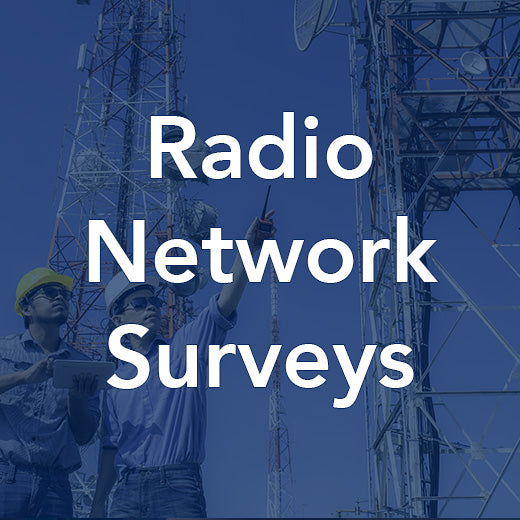
Radio Network Surveys
Course Code: MB1801 Course Summary To carry out meaningful radio surveys of GSM, UMTS, LTE and Wi-Fi networks demands a knowledge of how those networks operate and the key radio metrics. These are discussed in detail along with the types of surveys and information they can reveal. The course is focused on the practical issues of performing surveys backed up with demonstrations. The equipment and software used on this course includes the Rohde & Schwarz TSMA radio scanner, ROMES and NESTOR software as well as the QualiPoc, handheld survey tool. Who would benefit Those that need to create a ‘picture’ of the cellular radio network environment to aid coverage optimization, crime scene investigation, alibi verification, intelligence gathering and performance analysis. This course features the Rohde & Schwarz TSMA radio scanner in conjunction with the ROMES and NESTOR software as well as a drive test tool. Prerequisites Previous attendance on GSM, UMTS, LTE and Wi-Fi courses would be advantageous but not essential. Topic Areas Include Cellular radio principles Cellular radio spectrum and identities Wi-Fi radio spectrum and identities Radio measurements and metrics Cell selection and reselections for GSM, UMTS and LTE Location reporting in idle mode Mobility in Wi-Fi Connected mode activity for mobile devices Tools for radio surveys Spectrum occupancy Coverage surveys Base station position estimation Practical guidance for surveying
POA: Private Course
-
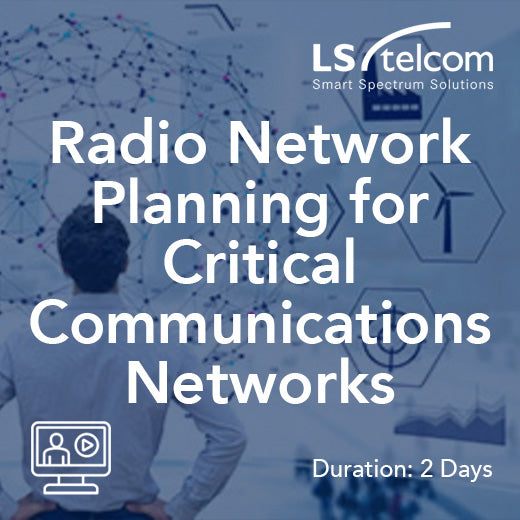
Radio Networks for Critical Communications (LS telcom)
Professional users in public safety, PPDR, transportation, utilities and industry must rely on efficient radio systems to provide wireless communication for support of their daily operation. Implemented radio technology, network design and user requirements must be carefully matched against each other. A solid understanding of users’ requirements and the possibilities and limitations of technologies is therefore essential. This course discusses issues which need to be considered when a radio system for critical communications shall be introduced or existing systems shall be replaced: Is it better to use services from an existing operator or to build and operate a dedicated network? Which deployment concept should be selected? How to define coverage and capacity? Which technology can provide the required services? These and other questions related to the design and introduction of RF networks for critical communications will be discussed. Starting with specific requirements, the course introduces services specific to critical communications, explains typical planning approaches and highlights possible implementation scenarios. A comparison of recent and upcoming radio technologies like TETRA, DMR, LTE as well as 5G for broadband applications completes the training. Course Objectives After completing the course, delegates will understand users’ requirements and limitations of current radio technologies like TETRA, DMR, LTE, 5G etc. They will know the technical and economic constraints of radio systems for critical communications and will be able to realistically assess the promises of system vendors and service providers. Intended for This course is intended for those who have basic knowledge in radio communication systems, who are interested in technical aspects for critical communications networks and who may be employed in telecoms regulators, organizations for public security and utility and transportation companies. Contents Introduction to radio networks for critical communications Requirements on communication services and applications Mobile broadband for PPDR Elements of a radio network for critical communications Planning and operation of a radio network Radio systems for critical communications (DMR, TETRA, LTE, 5G) About LS telcom: LS telcom is a global leader in technologies and consulting services for efficient radio spectrum use, optimizing spectrum management to ensure reliable, interference-free, and secure radio services. Our portfolio includes consulting, measurement services, and integrated solutions for planning, analysis, monitoring, and managing radio infrastructure. Serving customers in over 100 countries, including regulatory authorities, network operators, and industries such as transport, utilities, and security, LS telcom operates globally with subsidiaries and offices in locations like Germany, the UK, Canada, India, and the UAE. Headquartered in Lichtenau, Germany, LS telcom AG has been listed on the German Stock Exchange since 2001 (ISIN DE 0005754402).
£1,300.00
-
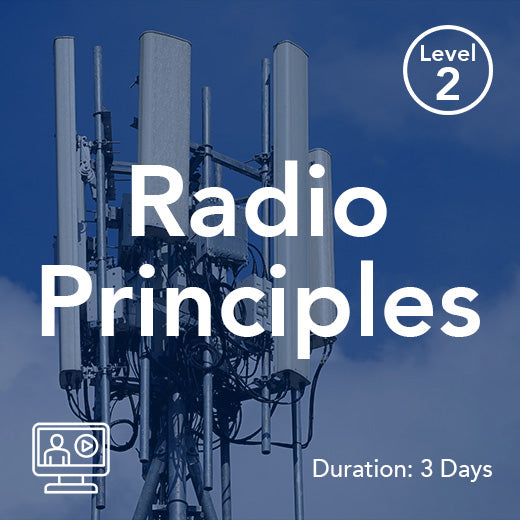
Radio Principles
The world has seen a phenomenal growth in the application and use of radio technology. What haven’t changed, however, are the principles upon which all of these technologies are built. The Radio Principles course provides an in-depth understanding of these principles on which radio technologies are built, taking students on a logical and detailed path through the various aspects of the theory, and practice, of radio communications. Through attendance on this course, delegates will build an understanding of how radio works and how this impacts manufacturers, users and operators of radio technology. Who would benefit Those requiring an understanding of the principles and concepts of radio that underpin today’s radio technologies. Prerequisites Some experience in telecommunications engineering is beneficial but the course is also suitable for delegates with an aptitude for technical subjects. Topic Areas Include The use and management of the radio spectrum Waveform fundamentals and baseband information Power levels and measurementsAnalogue and digital modulation techniques Simplex, semi-duplex and duplex - FDD and TDD Multiplexing – FDMA, TDMA, CDMA and OFDMA Transmitters and receivers Antennas and transmission lines Radio propagation mechanisms Introduction to coverage prediction Principles of cellular coverage techniques Diversity and MIMO An overview of fixed and mobile radio technologies in use today
£2,660.00
-
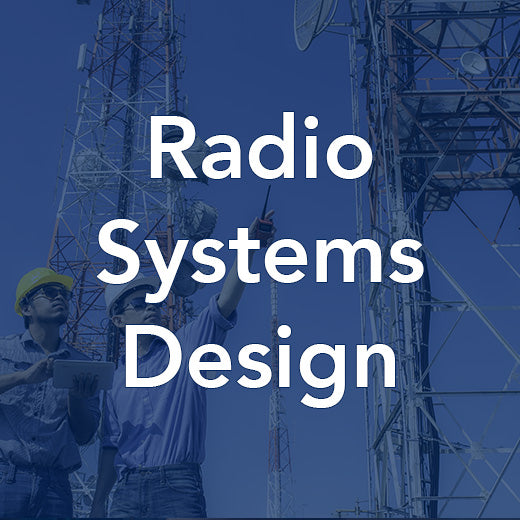
Radio System Design
Course Code: RP1101 Course Summary The course covers the essential information and practical skills needed to begin designing mobile and fixed radio systems. Who would benefit Those involved in the specification, design, planning, management and maintenance of mobile and fixed radio systems. Prerequisites A good knowledge of radio principles, a background in telecommunications engineering, or attendance on the Radio Principles course (RP1301). Topic Areas Include Spectrum regulation – ITU, CEPT, ECC, Ofcom Calculating gain, loss and power levels – the decibel Calculating noise levels in radio systems Interpreting antenna and feeder specifications Radio propagation mechanisms Radio propagation modelling Production of radio path profiles Calculating power budgets Calculating fade margins Diversity systems Planning coverage and capacity for mobile systems Radio site engineering Design a mobile radio system Design a fixed radio link Includes practical exercises throughout, including a system design exercise.
POA: Private Course
-
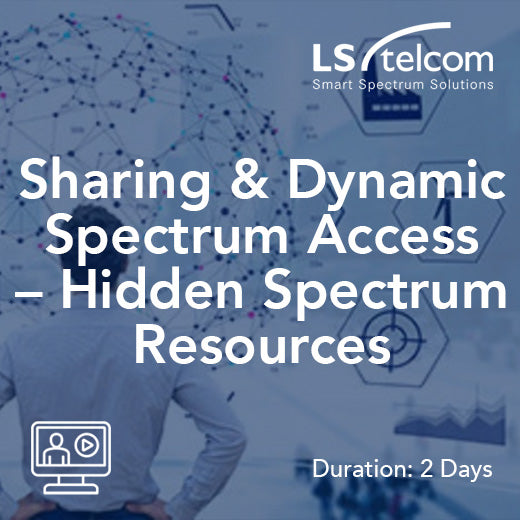
Sharing and Dynamic Spectrum Access – Hidden Spectrum Resources (LS telcom)
The planning rules for radio services often leave small gaps which cannot be used or the scattered use of spectrum by a primary user leaves larger opportunities. Such spectrum might be accessible for different or additional radio services, typically ones with very low power which will not cause undue interference to the primary users. These opportunities were referred to as ‘whitespaces’ but the focus more recently considers methods such as dynamic spectrum assignment. In addition, regulatory techniques are trying to find ways to make sharing spectrum a more common practice for use across a myriad of spectrum services. This course examines the background to whitespaces, considering how and where they arise and looks at a range of sharing opportunities. It then focuses on how spectrum might be made available to additional parties, and what kind of communications it might support. Finally, the various regulatory methods and technologies (including DSA/LSA and the role of databases) being considered will be examined. Course Objectives After completing the course, delegates will understand the history of whitespaces, and the more recent opportunities for sharing together with methods to regulate usage. Current developments and case studies will also be provided. Intended for those who need to understand the regulation and practical application of advanced sharing techniques, whether from a regulatory or commercial perspective. Contents The possible applications for more advanced spectrum sharing methods Technologies being developed for the exploitation spectrum sharing Where are there opportunities for more advanced sharing? How is interference dealt with The regulatory processes and procedures being applied Geographic databases and dynamic spectrum access Licensed shared access and similar regulatory tools About LS telcom: LS telcom is a global leader in technologies and consulting services for efficient radio spectrum use, optimizing spectrum management to ensure reliable, interference-free, and secure radio services. Our portfolio includes consulting, measurement services, and integrated solutions for planning, analysis, monitoring, and managing radio infrastructure. Serving customers in over 100 countries, including regulatory authorities, network operators, and industries such as transport, utilities, and security, LS telcom operates globally with subsidiaries and offices in locations like Germany, the UK, Canada, India, and the UAE. Headquartered in Lichtenau, Germany, LS telcom AG has been listed on the German Stock Exchange since 2001 (ISIN DE 0005754402).
£1,300.00
-
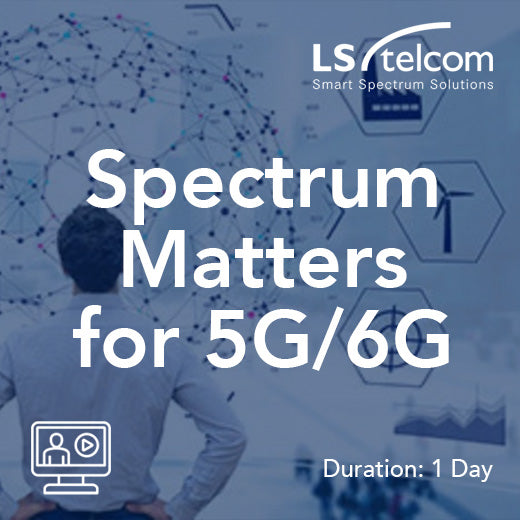
Spectrum Matters for 5G/6G (LS telcom)
5G is driven both by the need for mobile operators to continuously strive to satisfy the growing and unquestionable demand for mobile data, and to support new use cases and services. Regulators and governments have been involved in establishing policies and approaches to award spectrum, so that new 5G services can be rolled out to consumers, enterprises, public sector and government agencies alike. Questions remain about how much more spectrum is needed for 5G but also for what spectrum is needed for 6G which is due for commercialization in the early 2030’s. When it comes to the question of spectrum however, there are many different views about how growth in data traffic impacts upon demand for radio spectrum. It is also evident that below 6 GHz there is very little spectrum remaining that can be re-farmed for mobile services and much of the focus for new spectrum for future mobile (6G) services is concentrated above 6 GHz. How feasible is it to deliver mobile services at such high frequencies? Are there ways to use existing spectrum more efficiently, or are technologies such as LTE and 5G Advanced already very close to the limit of what is achievable? Course Objectives After completing the course, participants will have an understanding of how the evolution towards new standard cellular technologies 5G and 6G has meant identifying new spectrum, or at least one new band. Participants will also understand the practical utilization of ever increasing frequencies in a mobile environment, and whether 6G might mark the end to the hunger of mobile operators for more spectrum. Intended for Those who need to better understand the spectrum implications of 5G and 6G technologies, whether from a regulatory, commercial or technical perspective. Contents Forecasts of demand for data services Realistically forecasting spectrum demand Bands capabilities and issues with existing IMT bands New bands being considered for 5G and 6G services Propagation and coverage of bands above 6 GHz The spectrum efficiency of existing IMT technologies The 5G ecosystem A roadmap for the evolution of 5G services towards 6G Authorization of mobile spectrum About LS telcom: LS telcom is a global leader in technologies and consulting services for efficient radio spectrum use, optimizing spectrum management to ensure reliable, interference-free, and secure radio services. Our portfolio includes consulting, measurement services, and integrated solutions for planning, analysis, monitoring, and managing radio infrastructure. Serving customers in over 100 countries, including regulatory authorities, network operators, and industries such as transport, utilities, and security, LS telcom operates globally with subsidiaries and offices in locations like Germany, the UK, Canada, India, and the UAE. Headquartered in Lichtenau, Germany, LS telcom AG has been listed on the German Stock Exchange since 2001 (ISIN DE 0005754402).
£1,300.00
-

VoNR Call Flow Analysis (Lab Workshop)
Develop a deep understanding VoNR Call Flow and understand its role in the 5G Standalone Network with this 1/2-day Lab. The cloud-based lab provides participants with access to a fully emulated 5G System environment. Experiment with the configurations for various Network Functions within the 5G Core Network and build customized settings for signalling scenarios that will enable users to develop greater insight in to the operation of the 5G System. VoNR Call Flow Analysis Covering Voice over New Radio in a 5G SA network, it includes message flows for: Registration PDU session setup IMS and SIP signalling for VoNR Lab Features & Benefits Through a combination of hands-on experience and guided instruction our virtual labs allow users to explore signalling procedures in the 5G system. Our labs feature: A simulated 5G network - Provides hands-on experience and reinforces theoretical knowledge. Guided exercises for signalling scenarios - makes learning and applying new concepts straightforward. Wireshark (pcap) output files – detailed output files provide deep system insight. Cloud-based lab - available 24/7 on any connected device. Individual dedicate server - Ensures that your work is kept private and secure. Ongoing trainer support - ensures you get expert advice when needed. Full integration with Wray Castles training programmes - allows you to build bespoke learning pathways for specialist teams across your organisation. You can find more information on our labs and arranges a demo here.
POA: Private Course
-
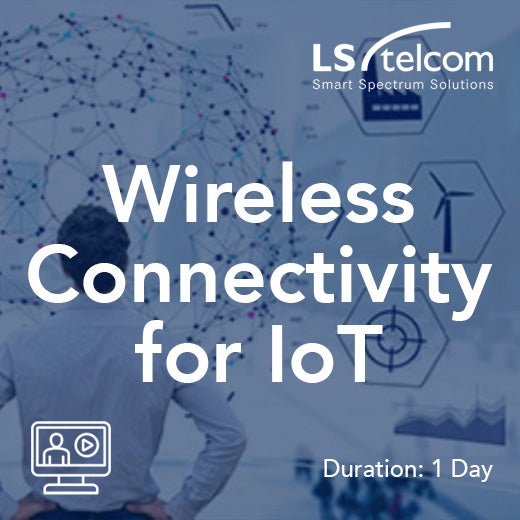
Wireless Connectivity for the Internet of Things (IoT) (LS telcom)
The Internet of Things (IoT) covers a huge range of use cases and applications and scales from single devices to massive systems with various elements connecting in real time. Wireless connectivity is an integral part of IoT. Depending on the application, factors such as range, data requirements, security, power requirements and battery life will dictate the choice of one or some form of combination of wireless technologies. Traditional cellular mobile networks based on 2G/3G/4G have almost ubiquitous coverage and high data rates but at cost of high power requirements at end user devices. Low Power Wide Area Networks (LPWAN) based on standards like LoRaWAN, Ultra Narrow Band (UNB) or NB-IoT, are expected to complement traditional connectivity solutions for long range communication. Short range technologies such as Bluetooth, BLE, ZigBee, WiFi or RFID will provide connectivity over short distances. And, of course, 5G presents another set of opportunities for IoT connectivity. This course explores radio technologies for IoT applications; discusses the underlying concepts and the resulting advantages and limitations. An analysis of spectrum requirements and availability complements the training. Course Objectives After completing the training, participants will be familiar with most recent radio technologies available to power IoT applications. They will understand the differences between the technologies, and the benefits and compromises of each. Intended for This course is intended for those who have basic knowledge in radio communication systems, who are interested in wireless systems for IoT applications and who may be responsible for implementing radio systems in industry. Contents IoT applications and communication requirements Overview on wireless technologies and approaches for IoT applications Spectrum requirements and availability Radio systems for Low Power Wide Area Networks Radio systems for Low Power Personal Area Networks 3GPP systems and the role of 5G for IoT About LS telcom: LS telcom is a global leader in technologies and consulting services for efficient radio spectrum use, optimizing spectrum management to ensure reliable, interference-free, and secure radio services. Our portfolio includes consulting, measurement services, and integrated solutions for planning, analysis, monitoring, and managing radio infrastructure. Serving customers in over 100 countries, including regulatory authorities, network operators, and industries such as transport, utilities, and security, LS telcom operates globally with subsidiaries and offices in locations like Germany, the UK, Canada, India, and the UAE. Headquartered in Lichtenau, Germany, LS telcom AG has been listed on the German Stock Exchange since 2001 (ISIN DE 0005754402).
£690.00
-

Wireless Networks Calculation Tool – CHIRplus_TC incl. Net Module (LS telcom)
The design of wireless networks considering mobile technologies such as mobile, TETRA, DMR, PMR or wireless IoT (Internet of Things) technologies (e.g. LoRaTM) requires complex calculations to dimension link capacity and link availability and to perform frequency assignment. Planning software like LS telcom’s CHIRplus_TC provides the required functionality in a user-friendly way and are essential for proper network design. A thorough knowledge of the available functionality and understanding of calculation results considerable shortens planning time and results in optimized network performance. The seminar introduces essential features to perform planning tasks for wireless networks systems. The first day is dedicated to the general tool handling. The different database functions and configurations are presented and discussed with the delegates. The following day will cover the necessary steps to perform typical wireless network calculations - from data input over the setting of required parameters to the calculationsanalyses. Finally, reports and data export options will be presented. An overview of the network technologies included in the Net Module will be introduced. The course is presented as classroom training with tool-based exercises to be done by the delegates. After a very short introduction with a few theory slides, the seminar will mostly focus on the topics by corresponding examples shown by the trainer and following dedicated exercises that are carried out by the delegates. Course Objectives After the training the delegates will be able to efficiently perform advanced network design and planning tasks using CHIRplus_TC. They will learn how to get best use on well-established engineering procedures and algorithms for wireless networks. Intended for This course is intended for those who have a basic knowledge in radio communication, who are interested in the functionality provided by CHIRplus_TC and who may be employed in telecoms regulators, telecoms operators, and utility and transportation companies. Contents Setup and configuration of CHIRplus_TC Interaction with the Graphical User Interface (GUI) Usage of databases and spreadsheets (especially filtering) Path profile and line of sight Net Module: Overview of network technologies Standardized data import and export Reports and documentation About LS telcom: LS telcom is a global leader in technologies and consulting services for efficient radio spectrum use, optimizing spectrum management to ensure reliable, interference-free, and secure radio services. Our portfolio includes consulting, measurement services, and integrated solutions for planning, analysis, monitoring, and managing radio infrastructure. Serving customers in over 100 countries, including regulatory authorities, network operators, and industries such as transport, utilities, and security, LS telcom operates globally with subsidiaries and offices in locations like Germany, the UK, Canada, India, and the UAE. Headquartered in Lichtenau, Germany, LS telcom AG has been listed on the German Stock Exchange since 2001 (ISIN DE 0005754402).
£1,300.00
-

Wray Castle Hub (12 Month Subscription)
Annual Telecoms Training Subscription Package with Unlimited access to 500+ hours of key training material Empower your professional development by building your knowledge of key technology and business topics within the telecoms industry. Unlimited access to future new courses that will cover the latest technology developments as they are added to Hub throughout your 12-month subscription period. Endlessly flexible and applicable to any role within the telecoms industry a subscription to Wray Castle Hub is your ultimate learning resource. You can choose to follow one of our suggested learning pathways, build your own or dip into the learning material module by module. The Wray Castle Hub is also available as an 6-Month Subscription for £945. Learn more here.
£1,400.00
-

Wray Castle Hub (6 Month Subscription)
6-Month Telecoms Training Subscription Package with Unlimited access to 500+ hours of key training material Empower your professional development by building your knowledge of key technology and business topics within the telecoms industry. Unlimited access to future new courses that will cover the latest technology developments as they are added to Hub throughout your 12-month subscription period. Endlessly flexible and applicable to any role within the telecoms industry a subscription to Wray Castle Hub is your ultimate learning resource. You can choose to follow one of our suggested learning pathways, build your own or dip into the learning material module by module. The Wray Castle Hub is also available as an Annual Subscription for £1,400. Learn more here.
£945.00








































